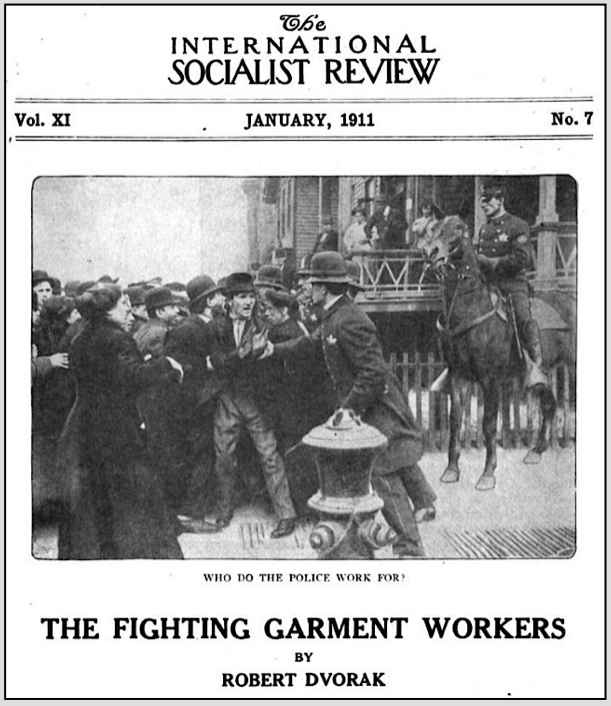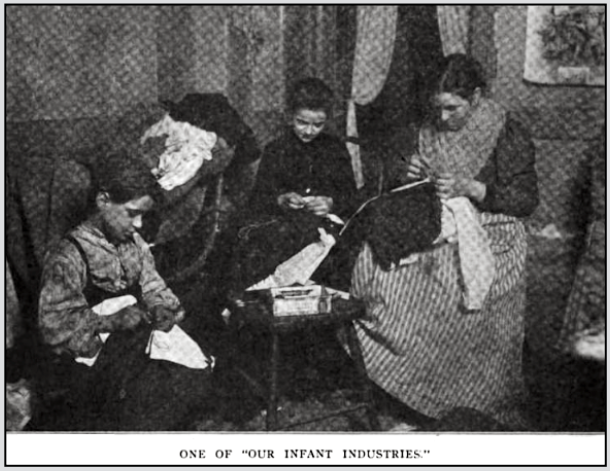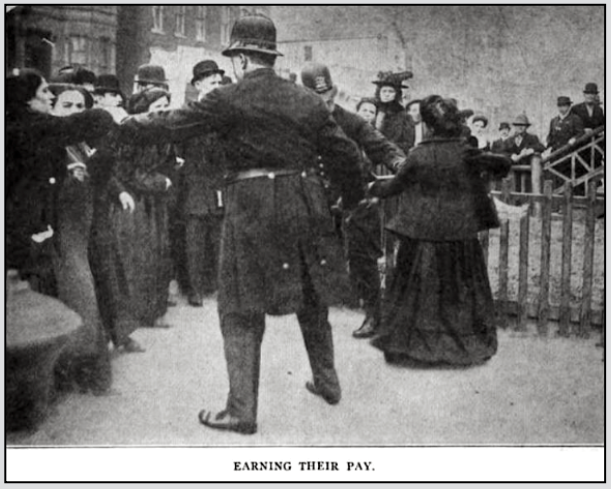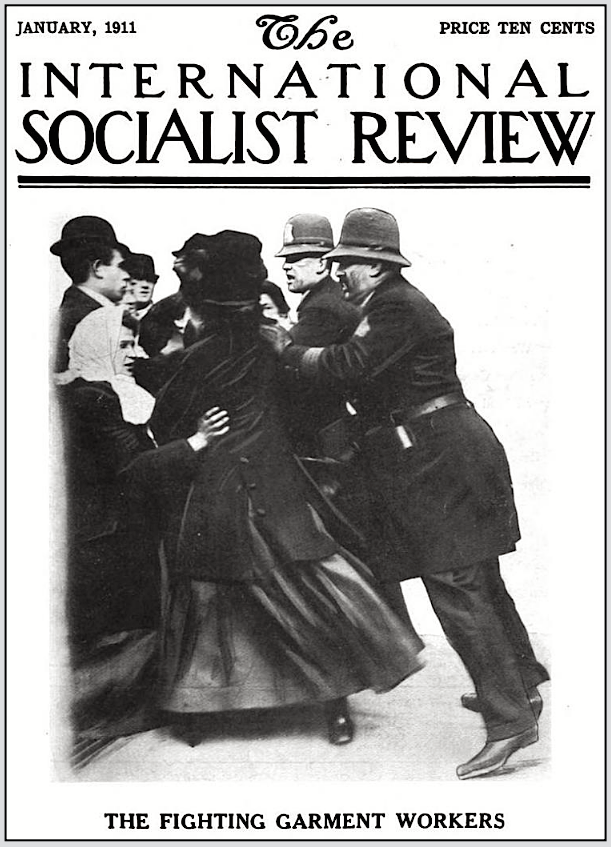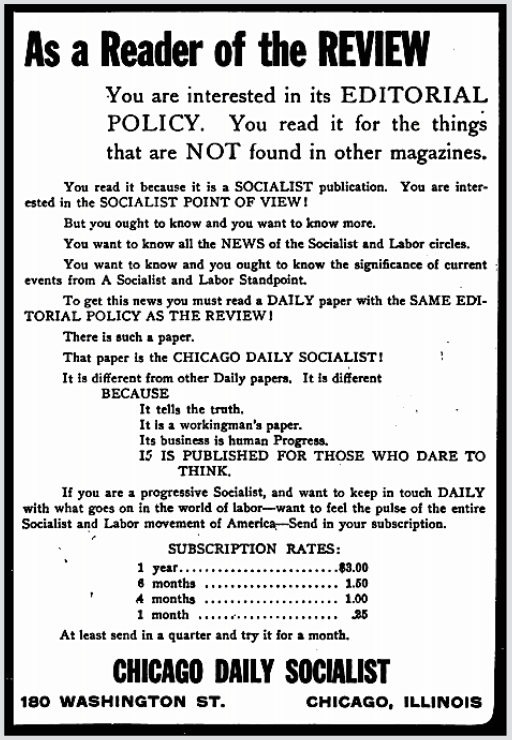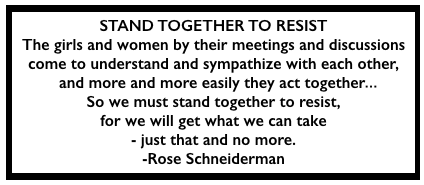 ———-
———-
Hellraisers Journal – Tuesday January 3, 1911
Chicago, Illinois – Garment Workers Strike Continues, Part I
From the International Socialist Review of January 1911:
[Part I of II.]
MAULED by city police, assaulted and beaten by armed, hired sluggers, shot by strike breakers and now being faced with a winter full of the horrors of cold and starvation, the striking garment workers of Chicago still remain undaunted.
Not even the best efforts of the mayor, the city council, the Chicago Federation of Labor and very influential persons, such as Raymond Robins and other “Good Samaritans” can force the “ignorant strikers” to accept meaningless but well worded terms of peace from the hard pressed renegades, Hart, Schaffner and Marx.
For the first time in history the autocratic Chicago Federation of Labor, headed by John Fitzpatrick, ably assisted by Mrs. Raymond Robins, has been nonplused. Over 41,000 garment workers have refused to obey the pleasure and whims of the leaders and have refused to go back to work upon the order of a president who tried to hand them lemons labeled as agreements and victories.
When the strike began on September 30th the Chicago Federation of Labor looked upon it as a joke. No one looked upon it seriously except the strikers themselves and a few of the garment workers’ leaders who were more intimately acquainted with the situation. There was a strike in existence, but few knew about it. The capitalist papers refused to write, and the Chicago Federation refused to act. A strike was on but no one knew its extent.
Then it was that the Chicago Daily Socialist, urged and entreated by the strikers, took action, and on October 7 published its first story of the strike and what brought it on. A week later the other daily papers took action, but not until after thousands of copies of the Daily Socialist had been distributed free of charge by the strikers in the city.
Before six weeks had passed by, a general strike of all the garment workers in the city, outside of those employed by union concerns, had been called. From an unorganized strike, composed of unorganized workers, sprang an organized movement for a recognition of the union, and the manufacturers, themselves harassed by internal fights over profits and business supremacy, grew uneasy.
Workingmen and women all over the United States, attracted by the brave and determined fight of the garment workers against the greatest odds, began to act. They refused to buy clothing without a label and warned local business men against buying clothing from the strike bound Chicago concerns, and the uneasiness of the manufacturers grew from day to day.
After the calling of the general strike there began in Chicago the greatest and most unique strike ever known in the history of labor struggles. Started by sixteen girls, without the vestige of organization, the struggle spread to 41,000 persons and tied up almost 200 shops.
Labor papers all over the country took up the astounding fight and unions began to send in cash donations. Farmers, the best customers listed on the books of the strike bound concerns, sent in letters and resolutions condemning the manufacturers and an entire fall and winter clothing trade was crippled or ruined.
Doctors agreed to treat patients free of charge. Barbers gave free shaves, theaters gave benefit performances. Private families housed and fed homeless strikers. Druggists gave free drugs or offered a certain percentage of their daily profits. Grocers and butchers gave free food supplies to the various free supply and relief stations. Clubs and societies gave benefit balls and entertainments. Song writers and artists offered their productions and gave the strikers the full profits and the hotel keepers refused to house the strike breakers.
Business and professional men, of whom the majority were members of the Socialist party, organized a strikers’ aid committee and in two weeks’ time collected over $3,000.
The strike was progressing admirably. Public sentiment was with the garment workers in every part of the country and money was just beginning to come in, when President T. A. Rickert, head of the national organization of the United Garment Workers, brought the strikers a peace offer from the Hart, Schaffner and Marx concern.
Rickert had signed the peace offer and tried to railroad it through the ranks. The offer guaranteed the workers nothing more than an assurance that every striker would be taken back irrespective of whether he belonged to a union or not, and a promise that many of the abominable persecutions would be abolished.
Hisses and angry cries greeted Rickert and his peace offer when he read it before the cutters at Federation hall, 275 La Salle street, Saturday afternoon, November 5. The same fate met the fatal agreement when it was presented to the strikers at Hod Carriers’ Hall, and at all the other meetings.
Dazed and dejected, Rickert abandoned all idea of settlement on the terms offered by Hart, Schaffner and Marx, and instructed his organizers to work as they had never worked before organizing and aiding the determined garment workers. For the first time in his life Rickert met determined workers who ignored the wishes and advice of their superiors and he submitted gracefully.
Later in the week, following his Waterloo, Rickert gave his one reason for endorsing the agreement. He stated that the demands for strike benefits had been so great and the income so small that he feared the possible suffering that was likely to follow inability to pay the men, women and girls. The starvation bogy had made its first appearance and was brushed away by the only people it could affect.
Their faith in Rickert and many of the other garment union officials shaken, the strikers with the aid of the Daily Socialist, of which over 10,000 extra copies had been sold one Sunday afternoon, following the rejection of the peace offer, appealed to the Chicago Federation of Labor for aid.
This time the federation, at its meeting, endorsed the strike of the garment workers and assessed its members 25 cents each. John Fitzpatrick, president of the Chicago Federation, and Mrs. Raymond Robins, president of the Women‘s Trade Union league, took the strike in hand and began work by appointing working committees composed of women prominent in Chicago.
Four food supply stations were established in various parts of the city and the strikers asking for help were given cards good for the amount food punched in therein. The supply stations lessened the demand for actual cash and the strike once more was progressing in a most satisfactory manner.
[Emphasis added.]
~~~~~~~~~~~~~~~~~~~~~~
SOURCES & IMAGES
Rose Schneiderman Quote, Stand Together to Resist Mar 20,
-NY Independent p938, Apr 1905
https://babel.hathitrust.org/cgi/pt?id=coo.31924106546991&view=2up&seq=962
International Socialist Review
(Chicago, Illinois)
-Jan 1911
https://www.marxists.org/history/usa/pubs/isr/v11n07-jan-1911-ISR-gog-Corn-OCR.pdf
Page 385 – “The Fighting Garment Workers”
by Robert Dvorak
https://play.google.com/books/reader?id=8-05AQAAMAAJ&printsec=frontcover&pg=GBS.PA385
See also:
Tag: Chicago Garment Workers Strike of 1910
https://weneverforget.org/tag/chicago-garment-workers-strike-of-1910/
The Chicago Daily Socialist (1906-1912)
(see esp issues from Nov-Dec, 1910)
https://www.marxists.org/history/usa/pubs/chicago-daily-socialist/index.htm
Ad for Chicago Daily Socialist from ISR p445, Jan 1911
~~~~~~~~~~~~~~~~~~~~~~~~~~~~~~~~~~~~~~~~~~~~~
Union Maid – Billy Bragg & Friends

